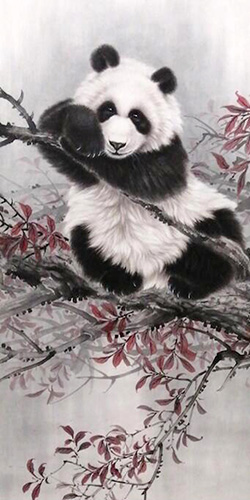



These will need to dry before painting any more details in the eyes. Use a round brush (or your finger!) to paint two small white circles for the eyes. I used the color light portrait pink and a #4 round brush.īasically paint the shapes of the bottom of the paws. Then paint little triangles for the claws on the front feet. Use the 10/0 liner and titanium white to lightly outline the legs and feet of the panda so you can see where the feet are overlapping.Īlso, outline the ovals on the feet a bit. Lightly outline the leg area of the panda with white I also made one white highlight line on the nose (it’s all about the details!).Ħ. I did fur sticking out of the ears, the top of the chest area, shoulders as well as white fir sticking out on the top of the head & bottom of the ears. Optional: paint some fur extending out to make the panda look a little “fluffy”īasically, paint some fur sticking out from the ears by painting little arc strokes that go in the direction of the shape. Then I used a 10/0 liner to paint the mouth under the nose.ĥ. I used both a #12 flat brush for the legs and feet and a #4 round brush for the black area around the eyes as well as the ears and the nose. It’s okay if you go outside the lines a bit too around the eyes! This can be fixed later when you paint the black. I used a #12 Flat brush to do this but you may wish to use a round brush.īasically paint in the white areas of the panda. For the purposes of demonstration – I outlined the drawing with chalk so that you can see where I am painting. You may also try outlining it with a sharpie or a paint pen. This may be helpful if you are painting with a child so he or she can see the panda better. Then (optional) use a piece of chalk to draw over the panda.
PANDA REFLECTION PAINTING FREE
You may also try to free draw the panda on the canvas with a piece of chalk. Place a sheet of graphite paper under the panda and trace over the print out. Transfer (or draw) the Panda to the canvas The background will not be one solid color of green, it will have areas of light and dark.Ģ. Make sure to apply the paint evenly but also the paint colors should look unmixed. Paint all up and down strokes on the canvas. Then double load your brush (dip it in both colors) in the hooker’s green and green gold. The water helps the paint spread a little faster. The reason to do this is because the background is supposed to be very “light” and “thin”. Start by dipping your brush in the water and applying a light wash of water on the canvas. You will need a 3/4″ flat brush and the colors green gold and hooker’s green. This medium allows her to relax and be free with the changeability of the material and exploration of color within the subjects she paints.Step By Step Directions: 1. Although Zeng explores other painting mediums such as gouache, pastel, and digital, oil and canvas feels the most natural. Since then, Zeng has flourished in her artistic expression, finding her true passion in oil painting. Transformed by the experience, she decided to revisit her art practice and make it her career regardless of the obstacles she would face. In 2017 due to physical complications, Zeng had to leave the chemistry industry. In her twenties she obtained her Masters in Science from SUNY College of Environmental Science and Forestry in Syracuse, New York. Zeng’s interest in the arts started in elementary school, sparking her desire to create later in life. With a style between impressionism and fantasy, she explores the vividness of their spirit in saturated colors and organic forms. Zeng’s artistic practice focuses on oil painting, with her subjects mainly being mythical creatures and animals.

Learn more Yue Zeng Yue Zeng is a Chinese-American self-taught artist, mother, and wife, who has been living in the United States since 2008 and currently resides in Woodbury, Minnesota.


 0 kommentar(er)
0 kommentar(er)
